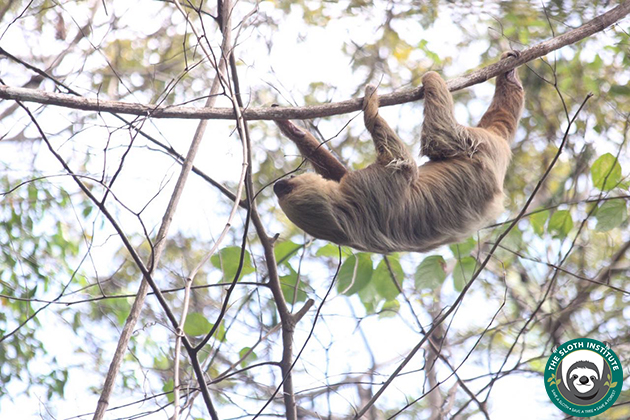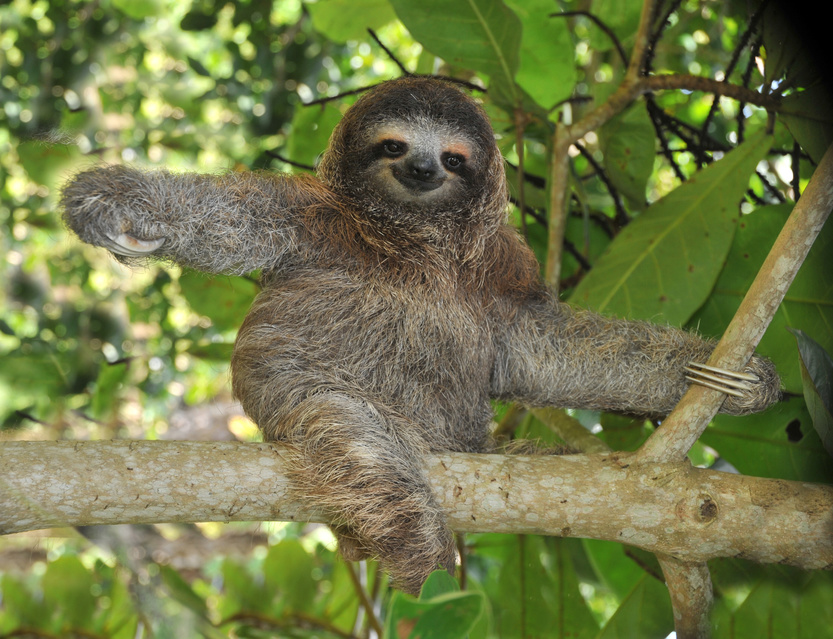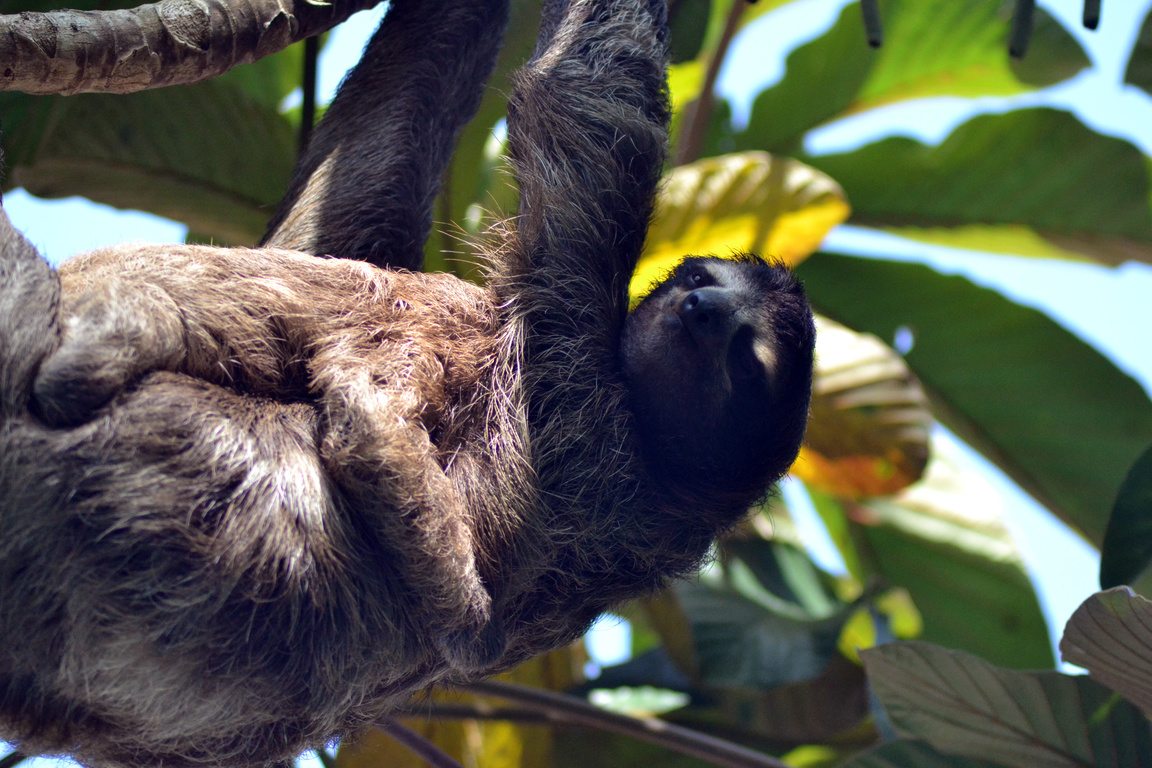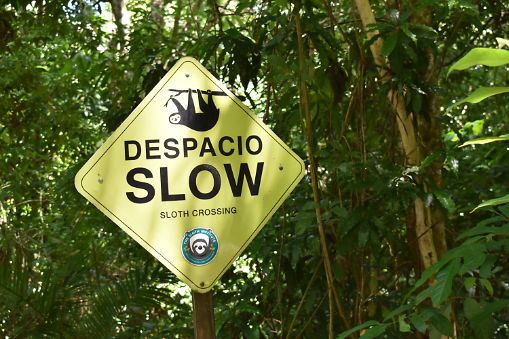What is it about the sloth that is so fascinating? In a recent commercial, Geico comedically featured the mammal in a game night — the sloth, of course, is noted for their slooooooow movement and known to hang upside down in the rainforest most of their life.
While on vacation in Costa Rica, VV contributor Lindy Tolbert witnessed the fragile and exciting wildlife at the Sloth Institute, a non-profit research and conservation facility for sloths in Manuel Antonio.

If you want to attempt to see the elusive sloth in the wild, one way is to visit the Sloth Institute. They host walks to spot sloths, but there’s a catch (at least for a few more months), as the walks are only offered for guests staying at Tulemar Resort and Vacation Rentals.
The backstory: Tulemar donated the sloth conservation areas where TSI was able to set up a research lab – basically a 20-foot shipping container – and release sites. They also promote and support TSI’s fundraising activities.
The good news: starting in January 2019, the Institute be offering a tour in Manuel Antonio National Park that is open to all!
Researchers at The Sloth Institute hand-raise, release, and track sloths to discover their behaviors and habitats. They work in conjunction with the Toucan Rescue Ranch to release sloths into the wild as well.
It’s crucial to understand that human interaction with sloths is not permitted, as it can be harmful to the sloths. But they are just as adorable (or intriguing!) whether from up close or far away.
The Sloth Walk
The experience starts at the entrance of the Tulemar Resort in Quepos, Costa Rica.
The walk itself isn’t actually all that long, maybe a mile or two at most, but the hills of Tulemar are quite steep, so most of your time will be spent scaling the hills and squinting up into treetops.
By the end of my two-hour walk, I saw three individual sloths; one was barely visible nested in a treetop, one was crawling between branches, and a third was about 20 feet from us in a very small tree.
Sloths aren’t the only things you’ll see, either. The resort is host to white-faced capuchins, squirrel monkeys, toucans, macaws, and many other species of colorful tropical birds.
Tips for Viewing
Sloths are notoriously difficult to spot, and that was indeed my experience. Their camouflage works incredibly well. Their beige, matted fur grows algae on it as a disguise and their slow pace makes movement hard to capture.
We walked for a good hour plus before we spotted any, even with the help of one of the institute’s delightful working grad students leading the way with her sloth antenna..
The Institute tags the animals with a GPS tracking system, which the antennae can then trace when researchers are looking at the track sloths’ movements.
But chances are, you will find some even if it takes a while and they’re far in the distance! If you have a professional telephoto lens, bring it; it’s challenging to snap a photo without one!
Facts about Sloths
- Their geographical range goes from Honduras to Brazil, and there are six different types in existence.
- In Costa Rica specifically, there are two types of sloths: two-fingered and three-fingered. (Note: “Two-Toed” isn’t really a thing. Three-fingered sloths are mostly diurnal but can be nocturnal, while two-fingered sloths are strictly nocturnal.) We mostly saw three-fingered sloths on the walk.
- They typically eat ficus, mango, and leaves, and spend as much time as possible up in the trees.
- They’re very slow, probably due to the fact that a one leaf-meal can take up to a month to digest and isn’t especially nutritious.
- The sloth mating ritual begins with the female releasing a scream that notifies nearby males of her burgeoning fertility, and males will fight each other in the trees by pawing at each other while hanging by their feet until one opponent falls off. The winner mates with the female.
- Mama sloths only have one baby at a time, but they can live with them for up to four years.
- Around 10,000 years ago, giant, elephant-sized sloths existed, but over time they evolved into a much smaller animal, around a mid-sized dog.
- Only about 25 percent of their body mass is muscle, so it’s no wonder sloths only move about 6 to 8 feet per minute. Their relatively glacial pace makes them hard for predators to spot.
- As so little of their body is muscle, they can’t shiver to warm up, and their digestion stops if they get too cold, which can cause them to starve to death. Fortunately, the rainforest isn’t cold very often, but when it is, this poses a risk to them.
- When they do come down from the trees, it’s usually to use the bathroom or cross a road, and road crossings are particularly dangerous for the slow sloths. Due to their long claws (topping out at 3 or 4 inches) and their angular wrists, crawling is an arduous process, and many sloths die every year being hit by cars or encountering dogs as they cross roadways. (Watch this video of a sloth trying to cross the road.)
- In order to combat this problem, researchers have placed green ropes over many roads so that sloths don’t have to descend to cross the roads. Though roads give them problems, sloths love swimming and are particularly good at the breaststroke.
- Sloths aren’t only armed with their sharp claws, however. Their bite can leave a deep wound and strong bacteria in their mouths can cause a wound to fester very quickly. In spite of their smiley appearance, they can defend themselves if needed.
How to Book a Sloth Walk
Tours take place daily at 9 a.m. (except for Sundays), and also at 3 p.m. on Mondays and Wednesdays.
Adults are $18, children 7 and under are free. Book online through Tulemar for tickets.
Sloth Facts sources from here.






 Subscribe to our email to get the latest news, travel tips, tricks of the trade, and our most recent posts delivered straight to your inbox monthly.
Subscribe to our email to get the latest news, travel tips, tricks of the trade, and our most recent posts delivered straight to your inbox monthly. 